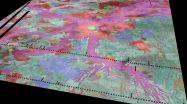(Press-News.org) Scientists at UCL have observed how a widespread polar wind is driving gas from the atmosphere of Saturn's moon Titan. The team analysed data gathered over seven years by the international Cassini probe, and found that the interactions between Titan's atmosphere, and the solar magnetic field and radiation, create a wind of hydrocarbons and nitriles being blown away from its polar regions into space. This is very similar to the wind observed coming from the Earth's polar regions.
Titan is a remarkable object in the Solar System. Like Earth and Venus, and unlike any other moon, it has a rocky surface and a thick atmosphere. It is the only object in the Solar System aside from the Earth to have rivers, rainfall and seas. It is bigger than the planet Mercury.
Thanks to these unique features, Titan has been studied more than any moon other than Earth's, including numerous fly-bys by the Cassini probe, as well as the Huygens lander which touched down in 2004. On board Cassini is an instrument partly designed at UCL, the Cassini Plasma Spectrometer (CAPS), which was used in this study.
"Titan's atmosphere is made up mainly of nitrogen and methane, with 50% higher pressure at its surface than on Earth," said Andrew Coates (UCL Mullard Space Science Laboratory), who led the study. "Data from CAPS proved a few years ago that the top of Titan's atmosphere is losing about seven tonnes of hydrocarbons and nitriles every day, but didn't explain why this was happening. Our new study provides evidence for why this is happening."
Hydrocarbons are a category of molecules that includes methane, as well as other familiar substances including petrol, natural gas and bitumen. Nitriles are molecules with nitrogen and carbon tightly bound together.
The new research, published today in the journal Geophysical Research Letters, explains that this atmospheric loss is driven by a polar wind powered by an interaction between sunlight, the solar magnetic field and the molecules present in the upper atmosphere.
"Although Titan is ten times further from the Sun than Earth is, its upper atmosphere is still bathed in light," says Coates. "When the light hits molecules in Titan's ionosphere, it ejects negatively charged electrons out of the hydrocarbon and nitrile molecules, leaving a positively charged particle behind. These electrons, known as photoelectrons, have a very specific energy of 24.1 electronvolts, which means they can be traced by the CAPS instrument, and easily distinguished from other electrons, as they propagate through the surrounding magnetic field."
Unike Earth, Titan has no magnetic field of its own, but is surrounded by Saturn's rapidly rotating magnetic field, which drapes forming a comet-like tail around the moon. In 23 fly-bys which passed through Titan's ionosphere or its magnetic tail, CAPS detected measurable quantities of these photoelectrons up to 6.8 Titan radii away from the moon, because they can easily travel along the magnetic field lines.
The team found that these negatively-charged photoelectrons, spread throughout Titan's ionosphere and the tail, set up an electrical field. The electrical field, in turn, is strong enough to pull the positively charged hydrocarbon and nitrile particles from the atmosphere throughout the sunlit portion of the atmosphere, setting up the widespread 'polar wind' that scientists have observed there.
This phenomenon has only been observed on Earth before, in the polar regions where Earth's magnetic field is open. As Titan lacks its own magnetic field the same thing can occur over wider regions, not just near the poles. A similarly widespread 'polar wind' is strongly suspected to exist both on Mars and Venus - the two planets in the Solar System which are most Earth-like. It gives further evidence of how Titan, despite its location in orbit around a gas giant in the outer Solar System, is one of the most Earth-like objects ever studied.
INFORMATION:
(WASHINGTON, June 18, 2015) - New research published online today in Blood, the Journal of the American Society of Hematology (ASH), concludes that a blood clot in an abdominal vein may be an indicator of undiagnosed cancer. The study also suggests that these clots predict poorer survival in patients with liver and pancreatic cancer.
Compared to the general population, individuals who develop blood clots in their legs (deep-vein thrombosis, or DVT) or lungs (pulmonary embolism, or PE) are two to four times more likely to be diagnosed with cancer within the next year. ...
Global warming leads to the ice sheets on land melting and flowing into the sea, which consequently rises. New calculations by researchers from the Niels Bohr Institute show that the sea level in Northern Europe may rise more than previously thought. There is a significant risk that the seas around Scandinavia, England, the Netherlands and northern Germany will rise by up to about 1½ meters in this century. The results are published in a special issue of the scientific journal Climate Research.
Sea level rise is a significant threat to the world's coastal areas, ...
Astronomers making a detailed, multi-telescope study of a nearby galaxy have discovered a magnetic field coiled around the galaxy's main spiral arm. The discovery, they said, helps explain how galactic spiral arms are formed. The same study also shows how gas can be funneled inward toward the galaxy's center, which possibly hosts a black hole.
'This study helps resolve some major questions about how galaxies form and evolve,' said Rainer Beck, of the Max-Planck Institute for Radio Astronomy (MPIfR), in Bonn, Germany.
The scientists studied a galaxy called IC 342, some ...
Patients seeking certainty in genetic tests often receive a perplexing result. Many learn they carry a 'variant of unknown significance' of a disease-linked gene. Such variants might -- or equally might not -- increase disease risk.
A study published in the June issue of the journal Genetics characterized nearly 2000 variants of the breast cancer-associated gene BRCA1, demonstrating the potential of a new approach for sorting out which variants are harmful and which are harmless.
Because genetic tests increasingly use more comprehensive multi-gene and whole-genome sequencing ...
ALLENDALE, Mich. -- A Grand Valley State University biology professor and her team of scientists have determined new information about an endangered species in the U.S., which could impact its protection under the Endangered Species Act.
The study, "Two Tickets to Paradise: Multiple Dispersal Events in the Founding of Hoary Bat Populations in Hawai'i," was recently published in PLOS ONE at http://journals.plos.org/plosone/article?id=10.1371/journal.pone.0127912.
The study, led by Amy Russell, associate professor of biology at Grand Valley, reveals that the Hawaiian ...
(Philadelphia, PA) - A little more than a decade ago, researchers discovered that all cells secrete tiny communications modules jammed with an entire work crew of messages for other cells. Today, a team of researchers, led by stem cell researcher Raj Kishore, PhD, Director of the Stem Cell Therapy Program at the Center for Translational Medicine at Temple University School of Medicine (TUSM), is harnessing the communications vesicles excreted by stem cells and using them to induce the damaged heart to repair itself. Their research is the June 19 cover story in the leading ...
PROVIDENCE, R.I. [Brown University] -- An international team of scientists has found some of the best evidence yet that Venus, Earth's nearest neighbor, is volcanically active.
In combing through data from the European Space Agency's Venus Express mission, the scientists found transient spikes in temperature at several spots on the planet's surface. The hotspots, which were found to flash and fade over the course of just a few days, appear to be generated by active flows of lava on the surface.
"We were able to show strong evidence that Venus is volcanically, and thus ...
Currently, there are more than 350 million type 2 diabetics and according to the World Health Organization (WHO) by 2030 it will be the 7th leading cause of death worldwide.
The hallmark of type 2 diabetes is insulin resistance, which is initially compensated for by an increase in beta cell size (responsible for producing insulin). However, the beta cells of such patients will eventually collapse and die, leading to full blown type 2 diabetes.
Researchers from the Laboratory of Cancer Metabolism at IDIBELL, led by Sara Kozma, have shown in animal models that inhibition ...
NEW YORK (June 18, 2015) - Proper laundering and handling are important in achieving and maintaining the hygienically-clean quality of healthcare fabrics and textiles delivered to the point of care, according to a new review that highlights evidence-based strategies to inhibit potentially serious contamination. The review, based on findings and recommendations from peer-reviewed studies, as well as current standards and guidelines, is published online in Infection Control & Hospital Epidemiology, the journal of the Society for Healthcare Epidemiology of America (SHEA). ...
Over 35 million people worldwide are currently infected by HIV. Antiviral therapies can keep the virus from multiplying. However, no drug can cure infection so far, because various cell types continue to carry the virus in a latent, i.e. quiescent, state. Scientists of Helmholtz Zentrum Muenchen have now established a model for latent HIV infection of brain cells. The researchers used this model to identify various compounds that affect latency of the virus in the brain. This study was published in the journal AIDS.
"Chronic infection is caused by long-lived cells with ...

